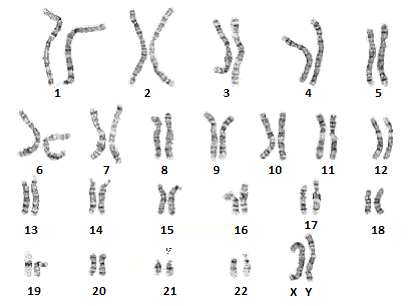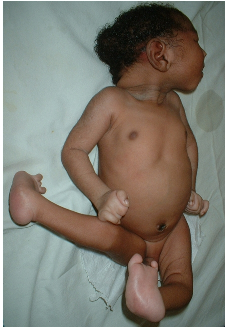Edward's Syndrome- Trisomy 18
Edward's syndrome is a genetic or chromosomal disorder in which an individual has 3 chromosomes in the 18th set of autosomes, instead of the normal amount of 2 chromosomes.
In human beings, a normal, healthy individual has 22 pairs of autosomes and one pair of sex chromosomes. Each pair out of these 23 sets (again, in a normal individual) consists of 2 chromosomes, for a total amount of 46 chromosomes.
However, an individual with edward's syndrome has an extra chromosome in the 18th set of autosomes,
so, in total, has 47 chromosome. An individual
with patau's syndrome can be male or female. Being that an individual has an extra chromosome in one of its set,
this is an abnormality and leads to developmental issues such as severe heart and kidney defects, convex plantar
surface of the foot, and abnormal, low set auriculae;
all these issues will be
explained and talked in more in-depth below.
Chromosomes of a Normal Healthy Individual
To show the contrast between a normal individual who has 23 pairs of chromosomes for a total of 46 chromosomes and an individual with edward's syndrome who has 47 chromosomes, we will look at the karyotype of both individuals, which shows the profile of each's chromosomes.
Below is the karyotype of a normal and healthy male individual:

You can see the 18th set, as they are numbered above, with 2 chromsomes. This is the amount of chromosomes that a normal individual has who has no irregularities in
genetic make-up.
Edward's Syndrome- Trisomy 18
However, a few individuals are born not with 2 chromosomes in their 18th set, but with 3 chromosomes. They are individuals with an extra chromosome in their 18th autosome set.
This is the reason why edward's syndrome is referred to also as trisomy 18. Because in the 18th set, there are 3 (tri) chromosomes.
Below is the karyotype of an individual with edward's syndrome:

You can see the extra chromosome present in the 18th set of autosomes.
Symptoms of Edward's Syndrome
The symptoms that result from an individual who has edward's syndrome are severe heart and kidney defects, convex plantar surface of the foot, and abnormal, low set auriculae.
- Severe heart and kidney defects- Individuals who have edward's syndrome are born with severe heart and kidney defects. In fact, most humans die in the fetal stage who have this syndrome. And those who do make it past birth do not live long, because of heart and kidney abnormalities.
- Convex Plantar of Foot- This is a condition in which the sole of a peron's foot is curved. Normally, a healthy human being has a flat foot sole. However, people with edward's syndrome do not; their feet are curved.
- Abnormal, low set auriculae- An individual with edward's syndrome may have his/her auriculae, which are the projecting part of the ear lying outside the head, lower than normal on the head. The ear, overall, may look abnormal.
Below is a picture of an infant with edward's syndrome:

You can see how this baby has convex-shaped soles on his feet, how his ears look abnormal and low set on his head. This is all characteristic of a person
with edward's syndrome.
Incidence of Edward's Syndrome
The incidence of individuals having edward's syndrome is 1 out of 8,000 live births.
Related Resources
Down's Syndrome
Patau's Syndrome
Turner's Syndrome
Klinefelter's Syndrome
Supermale- XYY Syndrome
Superfemale- XXX Syndrome
